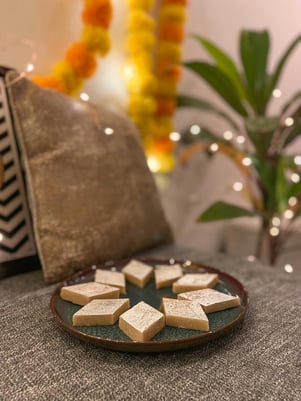The Chemistry of Diwali Disasters: How Science Saved Our Sweets
Blog post description.
Saumya Wagh
12/26/20242 min read


Hey science enthusiasts! Today I want to share a STEM story about how understanding chemistry saved our Diwali celebrations last weekend!
The Great Kaju Katli Catastrophe
Diwali was just two days away when Dad decided to surprise Mom by making her favorite sweet - kaju katli (cashew fudge). Dad's usually a great cook, but this was his first attempt at Indian sweets without Mom's supervision. I was doing homework when I heard him groan in frustration.
"It's all wrong!" he called out. I rushed to the kitchen to find him holding a tray of what should have been smooth, silver-topped diamond-shaped sweets. Instead, he had a sticky, grainy mess that refused to set properly.
The Scientific Investigation Begins
Being the chemistry nerd I am, I saw this as the perfect opportunity for applied science! We laid out the recipe and Dad's process:
He had ground cashews into a fine powder ✓
Made sugar syrup (1 cup sugar + ½ cup water) ✓
Mixed them together with cardamom powder ✓
Kneaded the mixture ✓
Attempted to roll and cut it ✗
The mixture was too grainy and wouldn't hold shape. Time to analyze what went wrong!
The Chemistry of Sugar Crystallization
First, I needed to understand the chemistry of kaju katli. This sweet depends on controlled sugar crystallization. When we make sugar syrup, we're creating a supersaturated solution - one that holds more dissolved solute than would normally be possible at that temperature.
As the mixture cools, sugar molecules try to return to their crystalline structure. In perfect kaju katli, these crystals should be microscopically small, creating that smooth, melt-in-your-mouth texture. But Dad's katli had large, grainy crystals - a classic crystallization problem!
As I researched more, I found out that larger crystals form when:
The cooling happens too slowly
There's insufficient agitation during cooling
Seed crystals are present that promote crystal growth
The Culprit: Sugar Science
After questioning Dad about his process, I found two critical errors:
Incorrect Sugar Syrup Consistency: He hadn't boiled the sugar to the right temperature. Proper kaju katli requires the "one-string consistency" (240°F), where the syrup forms a single thread when dropped from a spoon. Dad had eyeballed it rather than using a candy thermometer or the traditional thread test.
Improper Cooling Method: He had let the mixture cool completely before kneading, giving sugar molecules plenty of time to form large crystals.
The Scientific Solution
Armed with this knowledge, we started over with some modifications:
We used a candy thermometer to heat the sugar syrup to exactly 240°F (the soft-ball stage).
Added a teaspoon of glucose to the sugar solution - this introduces different sugar molecules that interrupt the formation of large sucrose crystals.
Kneaded the mixture while still warm (using silicone gloves to protect our hands).
Added a tiny bit of ghee during kneading to coat the sugar molecules and prevent them from sticking together in large crystals.
The result? Perfectly smooth, melt-in-your-mouth kaju katli would have impressed even my grandmother!
The Science Beyond Sweets
This experience taught me how understanding phase transitions, supersaturation, and crystallization applies to cooking. These same principles appear in:
The tempering of chocolate (controlling cocoa butter crystal formation)
Making smooth ice cream (preventing large ice crystals)
Even in metallurgy and pharmaceutical development!
Who knew that the chemistry we learn in school could save our Diwali celebration? Now Dad calls me his "sweet scientist" and consults me before attempting any complex recipes.
For my fellow Indian American teens celebrating Diwali, remember that our traditional recipes aren't just delicious—they're edible science experiments that connect us to both our heritage and the universal laws of chemistry!
